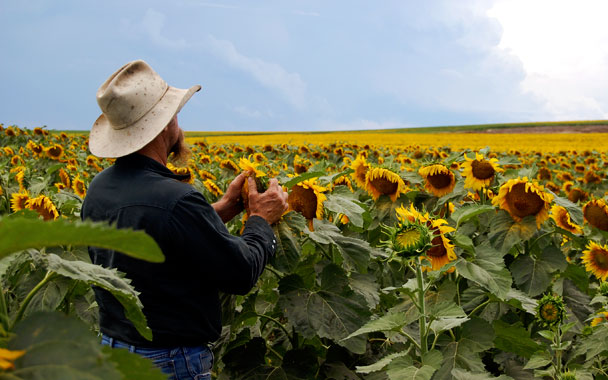The northern plains are aflame with the gaudy yellow spectacle of the sunflower bloom. The pageantry of the opening ceremony of the Beijing Olympics has nothing on this synchronized, sun-celebrating, march of the sunflowers through an average day. But beneath the spectacle, a war is going on.
Sunflowers suck nutrients out of the soil so quickly that they are one of the most ecologically destructive crops in the monoculture crop rotation on a modern farm. Many farmers grow corn two years in a row in the same field. Some even tempt fate and grow corn three years before rotating to soybeans. But the decision to plant sunflowers in a field one year is a decision to spend big bucks to restore the nutrients in that field for a new crop the very next year. In a well-tended sunflower field, nothing else survives, no weeds and no wildlife, of course, except enormous flocks of blackbirds which can devour 100 acres in a week unless the farmers drive them away with propane boom cannons. As the fields ripen, the birds have just begun to arrive. The cannons will start to boom next week.
This summer, the farmers here are fighting an infestation of a smaller pest, sunflower-seed weevils. Jim Lutter has been in the air with his spray plane nonstop for 10 days, trying to drench the outbreak in pesticide. Seed weevils are a microscopic bug with a huge proboscis that pierces a sunflower seed and sucks on it. “You know when you’re eating seeds at a ball game,” Jim explains, “and you crack a shell open with your teeth and it’s soggy, and there’s no seed inside, a seed weevil has been there.” Half a day after he sprays, Lutter is in the field checking flowers. Dozens of weevils are dead on the leaves of each plant.
This petrochemical-intensive war is one reason why Lutter doesn’t grow sunflowers himself. While he is spraying his neighbor’s fields, his hired hand is, at long last, mowing Lutter’s intermediate wheatgrass field. Intermediate wheatgrass isn’t native to the American plains, but it’s as close as a farmer can get. Native grass seed is too rare, too expensive to plant, and besides, there is no market for it.
Standing in his thick grass, Lutter can hear the pheasants running. His field is a breeding paradise for them, and that will pay off in the fall, when hunters arrive. Because wheatgrass is a perennial, which means it will grow again next year, Lutter doesn’t have the annual expenses of field preparation—planting, fertilizing, cultivating, and pesticide and weed control—so he expects to make around 70 cents a pound on 500 pounds of grass seed an acre. That’s $350 an acre on land that Jim originally bought for $300 an acre. Those aren’t corn profits, but they are healthy, and not tied to the roller coaster of the oil market. After the wheatgrass has been combined for seed, Jim will bale it for hay and feed it to the buffalo this winter.
There is an expectation among many in the public that all the expensive high-tech equipment of modern farming increases yields. We keep re-inventing and improving seeds, making them pest-resistant, even drought-resistant. We innovate planting strategies and spray against pests and weeds. We build bigger and better combines. But Lutter maintains that, “the difference between a sixty-bushel-an-acre wheatfield and an eighty-bushel-an-acre field is who’s driving the combine.” Contract crews are paid by the acres they work, so they have an incentive to work fast, rush through a field, and not stop to clean their equipment when it gets clogged up with weeds. The result is less wheat in the bin and more on the ground. Good for the birds, bad for the bottom line. “I have a neighbor who did an experiment with his wheat harvest.” Jim tells me. “He ran his combine at three miles an hour, which is a lot slower than most commercial crews. He got seventy-two bushels an acre. Then he slowed down to one mile an hour, and got ninety-two bushels an acre. Slower is more efficient if it’s your wheat left on the ground, especially at eleven dollars a bushel.”
“I wish I could start a company that just took the extra grain out of every field I could combine at a slower pace. I’d tell the farmer, ‘Ill work for what would have been waste.’ I could retire to the Bahamas.”




 Pinterest
Pinterest


